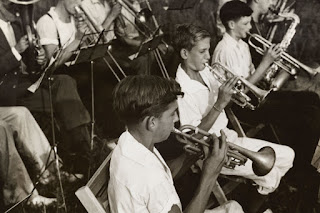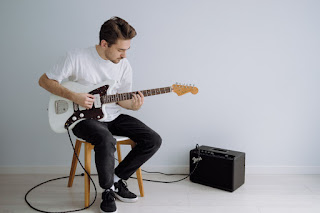The rhythm section is the heart and soul of any school’s jazz band. The larger style jazz bands have evolved as a result of the big band movement in modern jazz. In essence, the rhythm section has a true function, within the jazz ensemble, that all horns listen to. They are responsible for contributing to the melodic and harmonic functions as well as tempo and direction.
Rhythm Section Instrumentation
A jazz band rhythm section generally consists of a minimum of three different players. These players include the piano, bass and drums. Typically many high school and middle school jazz bands will also incorporate electric keyboard, electric bass and a variety of other percussion instruments. The double bass or the electric bass is important for the success of a jazz band. If an acoustic double bass or electric bass player do not exist within the group then seriously consider rewriting the parts for an electric keyboard player.
Traditional jazz bands typically did not use electronic microphones to reinforce their sound. The exception to this rule is for vocalists. However, more modern ensembles use microphones with the string bass, piano or instrumental soloist.
The reason for this sound reinforcement pertains to the value based on balancing the rhythm section along with the entire jazz ensemble. Extensions of the rhythm section also include the guitarist and the vibraphonist. Many high school and middle school groups strive to develop the entire percussionist. As a result of adding a vibraphone and other percussion instruments, the melodic and harmonic accompaniment of the ensemble is strengthened.
The Responsibilities of the Rhythm Section
The primary responsibility of the rhythm section is to keep time. A grooving and musically communicative rhythm section will find the necessary comfort level to provide the driving support necessary for the overall jazz ensemble.
The piano, guitar and bass provide the harmonic motion that outlines the progression of what is being played. In addition, the drum set keeps the rhythmic and stylistic components driving the ensemble proper by including fills in strategic locations and playing on beats 2 and 4 with the hi-hat and cymbals. As a result, the better the rhythm section feeds off each other the better the jazz ensemble as a whole sounds.
Rhythm Section Set-Up Arrangements
As we have established before the rhythm section is vital to the success of a jazz ensemble. It is important that the section is balanced and every instrument is heard at one point or another. Sometimes music educators feel like the rehearsal room dictates the formation in which a rhythm section should be arranged. However, it’s important for the students to be able to hear each instrument in the ensemble. If something can’t be heard, the performance quality of the group will be affected.
Some of the most popular jazz ensemble set-ups include the saxophones, trombones and trumpets being blocked together. Many times the rhythm section is placed to the left of the director. Often, many groups will face the amplifiers towards the audience. It is best for the jazz musicians to have this amplification targeted in a diagonal effort, across the horn section.
If a director is lucky enough to have a grand piano player it is advised to have the lid open facing the audience and the jazz band. This allows players to hear what’s going on in the rhythm section and provides the player a better line of sight to the band director.
If the jazz band has an upright piano it is best to face the instrument in a manner so that the soundboard of the piano is angled toward the rhythm section as well as the rest of the band. Electric keyboards should have their amplifiers facing in the same direction as the electric guitar and the electric bass. These devices should be directed diagonally across the jazz ensemble.
The guitarist should be placed behind the drummer and near the bass player. Note that in situations where there is an acoustic guitar it would be appropriate to place the guitarist near the piano.
The bass player should be closest to the trumpets with the guitarist at his side. The vibraphone and additional pit equipment should be placed in front of the rhythm section in order to achieve proper balance and projection.
The “V” Set-Up
If you are looking to have the trombones and trumpets hear the sax section better, try the “V” setup. Such as its name suggests, the horn block is shifted in a “V” shape. This is done so that the sax line is on the director’s left, next to the piano, and connected diagonally to the trombones and trumpets to the right. The rhythm section generally stays connected with a slight shift with the remainder of the section being centered behind the “V” shape.
Other Set-Ups
The inverted “V” set-up for jazz ensembles is often used for recording. Members can easily hear each other. Another rehearsal set-up includes the square set-up. Often band directors will have their students face inwards when using the square set-up. The rationalized reason for using this set-up is because players experience a heightened aural experience in rehearsal.
How to Rehearse a Rhythm Section
Running a high powered rhythm takes attention and time. Similarly to any significant personal relationship, a rhythm section needs to know how his or her fellow musician operates and can read them (metaphorically speaking that is.)
When scheduling rehearsals with a jazz ensemble, especially at the high school level, designate a student leader that can rehearse each section. Not all sections will need the same amount of director focused time. In the horn section, each player has a specific role to play.
In contrast, everyone in the rhythm section will be featured. As a result, there is a heightened need for all rhythm section members to practice observing, listening and being featured as a soloist. Subsequently, the section has a better chance at becoming a cohesive unit.
Band directors should ask students if they hear what you are asking them to listen for. If they don’t hear this, provide professional recordings for them to listen to. Point out key instrumental performance practices that they should listen to in each recording. As an educator, you may need to provide supplemental exercises, such as ones that utilize the 12-bar blues, and activities that strengthen stylistic skills.
Inexperienced players will need to learn when to stay out of each other’s way when “comping.” This is when the players are playing chords, rhythms and countermelodies that take place during melody lines or solos. Often inexperienced players will clutter the harmonic and functional drive of the chart.
Try This in Rehearsals
When starting a rehearsal with a rhythm section, be sure that all instruments such as the guitar, and bass do a quality tuning. Often the electric instruments play too loudly and then there is generally too much bass being amplified through the speakers. Consider adding some treble amplification to balance this out a bit.
Often student percussionists want to fill the role of the rock drummer. The problem with this is that it overpowers the band. Redirect your percussionist by having them focus on the ride-cymbal and the backbeat with the hi-hat. Steer the majority of the playing away from putting too much emphasis of the downbeat on the bass drum and the snare drum on the up-beat.
Most importantly, the drum-set player must be able to hear and “sync-up” with the bassist in order to keep time consistent. Subsequently, the guitarist needs to find a proper blend within the sound of the drum-set and bass.
In essence, the guitarist should work to find a balance and blend between the bass and drums. As mentioned previously, the guitar and piano have the ability to clutter the harmonic line by comping. Be sure to define when each instrument should take the lead and fill this role in the chart.
The Concept of Comping
Comping refers to the idea of harmonic and rhythmic accompaniment. In addition, “comping” also focuses on the act of how a rhythm section accompanies soloists. In most middle school and high school jazz charts, publishers often provide a roadmap of a clear chord progression.
The pianists should generally take the lead in how rhythms are played during this progression. In turn, guitarists should be careful to play rhythms that are complementary and don’t clash with the piano rhythms.
Listening to Jazz
Ultimately, listening to professional jazz recordings cannot be over emphasized as being an excellent tool for developing a great rhythm section sound and identity. Organizations such as the military jazz bands provide free opportunities for middle and high school students to see quality live performances. Even the use of social and educational media, such as YouTube, provide our students exposure to grade A quality performances.
Method books and supplemental aides also provide useful jazz education material to provide listening opportunities for students. As a result of making listening to jazz music a priority, students gain a heightened perspective of its importance.
In conclusion, by modeling your passion for jazz your students are more likely to be actively engaged and become consumers of jazz music in their future. Be the leader, advocate and usher in the future of jazz education.







